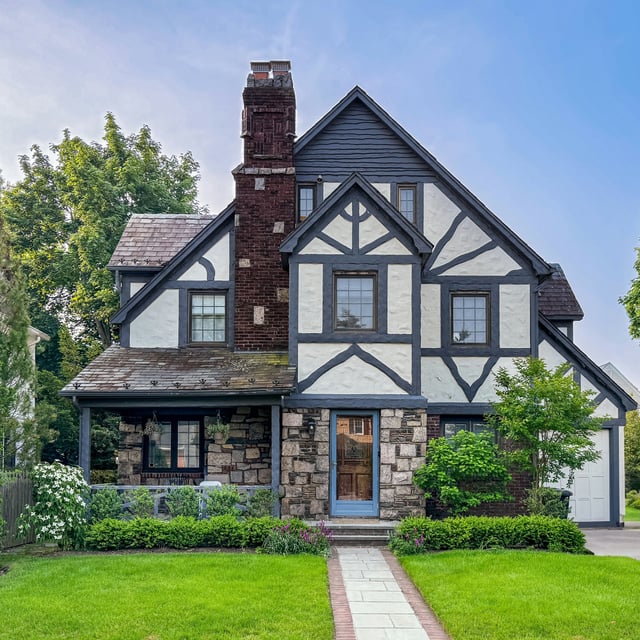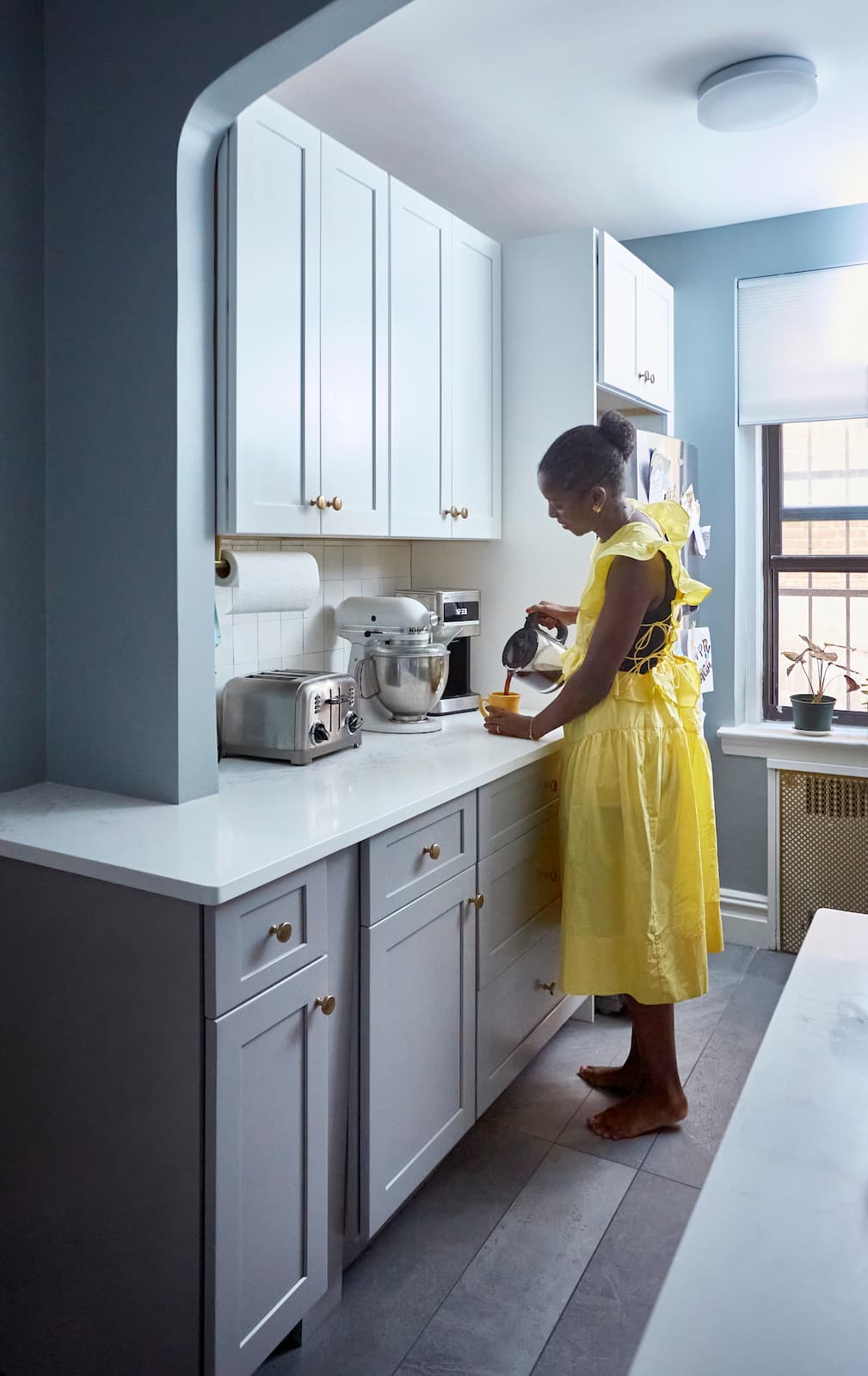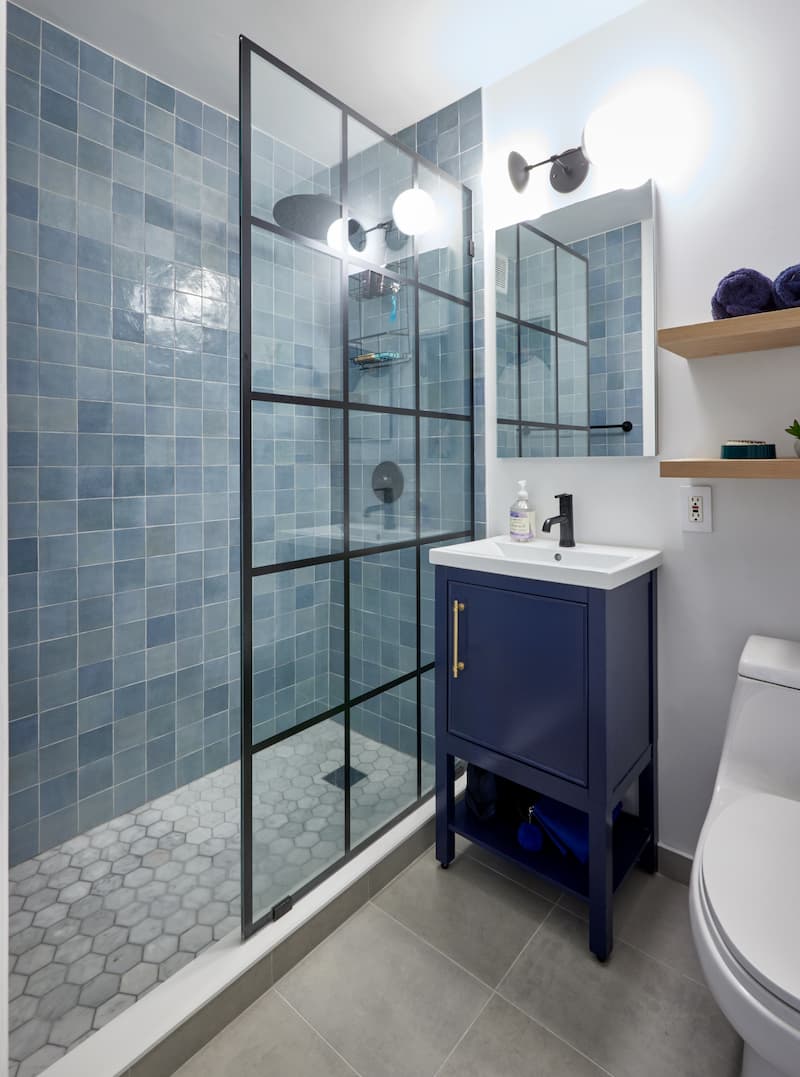Tudor Home Renovation Design Tips

In This Article
Tudor homes have a quiet enchantment that sets them apart. With steeply pitched roofs, decorative half-timbering, and storybook silhouettes, they remain one of the most distinctive architectural styles in the U.S. Inspired by late Medieval English cottages and manor houses, Tudors gained popularity in the 1920s and ’30s, especially in cities like New York, Chicago, Boston, and Los Angeles. Today, they’re tucked into established, leafy neighborhoods—think Ditmas Park in Brooklyn, Beverly in Chicago, Brookline in Boston, or Pasadena—where leaded glass windows and gabled facades signal their enduring charm. Renovating a Tudor isn’t just about updates. It’s about honoring its architectural backbone and adapting it with care.
Design Choices That Honor Your Home’s Tudor Backbone
Maintain or Add Wood Throughout
Wood is the soul of a Tudor home, and preserving or thoughtfully adding wood details can make all the difference to your renovation. Exposed ceiling beams—whether original or newly added—instantly evoke the home’s historic roots. Consider restoring or installing dark-stained wood paneling in living rooms or studies, which adds warmth and a sense of gravitas.
For floors, wide-plank oak or walnut boards feel both authentic and inviting. Even smaller touches, like wood-framed windows or custom millwork around doorways, can reinforce the Tudor aesthetic. If you’re remodeling cabinetry or built-ins, opt for rich, natural finishes that let the wood’s grain shine through.
Color Scheme
The classic Tudor palette is based on earth tones and natural hues, reflecting the materials used in original construction. To maintain Tudor undertones when remodeling your home, design with creamy whites, warm taupes, and deep browns for walls and trim, accented by muted greens, burgundies, or navy blues. These colors create a cozy, enveloping atmosphere that feels both timeless and welcoming.
If you want to modernize, consider softening the contrast between timber and stucco with lighter stains or off-white paints, but always keep the look grounded in nature. Avoid overly bright or synthetic colors, which can clash with the home’s historic character.
Leadlight and Mullioned Windows: Preserving the Tudor Gaze
Tudor homes are famous for their distinctive windows—leaded glass, diamond panes, and elegant mullions that filter sunlight in a way that feels both dramatic and intimate. If your home still has its original windows, prioritize their restoration; repairing leaded glass or refinishing wood frames can make a world of difference. For replacements, seek out custom windows that echo the original patterns and proportions. Even adding interior window grilles or decorative glass film can help recapture that classic Tudor look without a full overhaul.
Arches and Doorways: Embracing Curves and Character
Arched doorways and passageways are a hallmark of Tudor architecture, lending a sense of old-world craftsmanship and flow between rooms. If your home already features these details, highlight them with subtle paint contrasts or restored wood trim. For renovations, consider adding new arched openings or even arched built-ins to echo the home’s original style. These gentle curves soften transitions between spaces and add a layer of architectural interest that’s both functional and beautiful.
Renovate with confidence every step of the way
Step 1: Personalize Your Renovation Plan
Step 2: Receive Quotes from Trusted Contractors
Step 3: Let Us Handle the Project Details

Tudor-Specific Home Remodeling Tips
Budget for Authentic Materials
If you’re committed to using true-to-form Tudor materials—like hand-hewn beams, slate roofing, or custom leaded glass—be prepared for a higher price tag. These materials are often more expensive and may require specialized craftspeople to install or restore during your renovation.
However, even small authentic touches can have a big impact, so consider where to splurge and where to save. For example, faux beams or engineered wood can offer a similar look at a fraction of the cost. Prioritize the details that matter most to you and your home’s story.
For related tips on budgeting your Tudor renovation, read Remodeling an Old Home on a Budget.
Maintain Tudor-Style Roofs
The steep, multi-gabled roofs that define Tudor homes are beautiful but can be a maintenance challenge. Original slate or clay tiles are durable but costly to repair or replace, and their complex shapes can make leaks more likely if not properly maintained.
Regular inspections are essential—look for missing or cracked tiles, and clear debris from valleys and gutters to prevent water damage. If you need to replace roofing, consider modern composite materials that mimic the look of slate but offer better durability and lower maintenance. Investing in roof care not only preserves your home’s character but also protects its structure for decades to come.
Widen Entryways Between Rooms
Many Tudor homes feature a series of smaller, enclosed rooms—a layout that can feel cozy but sometimes cramped by modern standards. Widening entryways between living spaces is a smart investment, allowing for better flow and more natural light while still preserving the home’s architectural integrity. Arched or timber-framed openings can echo original details and add visual interest. This approach lets you enjoy a more open, connected home without sacrificing the intimate charm that makes Tudors so special.
Open Up the Kitchen
Tudor kitchens are often compact, tucked away from the main living areas. If you’re renovating, consider opening up the kitchen to adjacent rooms or adding a breakfast nook beneath a window. Use cabinetry with classic details—like inset panels or iron hardware—to maintain period charm, and maximize storage with clever built-ins. Lighten up the space with a mix of natural and task lighting, and don’t be afraid to introduce modern appliances in finishes that complement the home’s palette. Even small remodeling changes, like a farmhouse sink or butcher block counters, can make the kitchen feel both functional and true to its Tudor roots.
For more inspiration, read Great Kitchen Configurations: Ideas to Transform Your Layout.
Renovate the Attic and Embrace the Pitched Roof
The dramatic, pitched roofs of Tudor homes often hide untapped attic space with incredible potential. Renovating the attic can create a cozy retreat, home office, or extra bathroom—just be sure to highlight the unique angles and exposed rafters. Skylights or dormer windows can flood the space with natural light, making it feel larger and more inviting. Use built-in storage to make the most of awkward nooks, and choose finishes that echo the rest of the home’s materials and color scheme. Embracing the attic’s quirks can turn it into one of the most memorable spaces in your Tudor home.
Design a Home That’s Uniquely Yours
Block can help you achieve your renovation goals and bring your dream remodel to life with price assurance and expert support.
Get Started
Give Your Tudor Home the Skilled Remodeling It Deserves With Block Renovation
Renovating a Tudor home is a unique opportunity to blend historic charm with modern comfort, but it requires a thoughtful approach and expert guidance. That’s why Block Renovation will handpick contractors for your specific project that understand the nuances of Tudor homes. They can partner with you to respectfully preserve the character that makes your home special, while introducing updates that enhance everyday living.

Written by Block Renovation

Renovate confidently with Block
Easily compare quotes from top quality contractors, and get peace of mind with warranty & price protections.
Thousands of homeowners have renovated with Block

4.5 Stars (100+)

4.7 Stars (100+)

4.5 Stars (75+)
Renovate confidently
- Top quality contractors
- Warranty & price protections
- Expert resources

